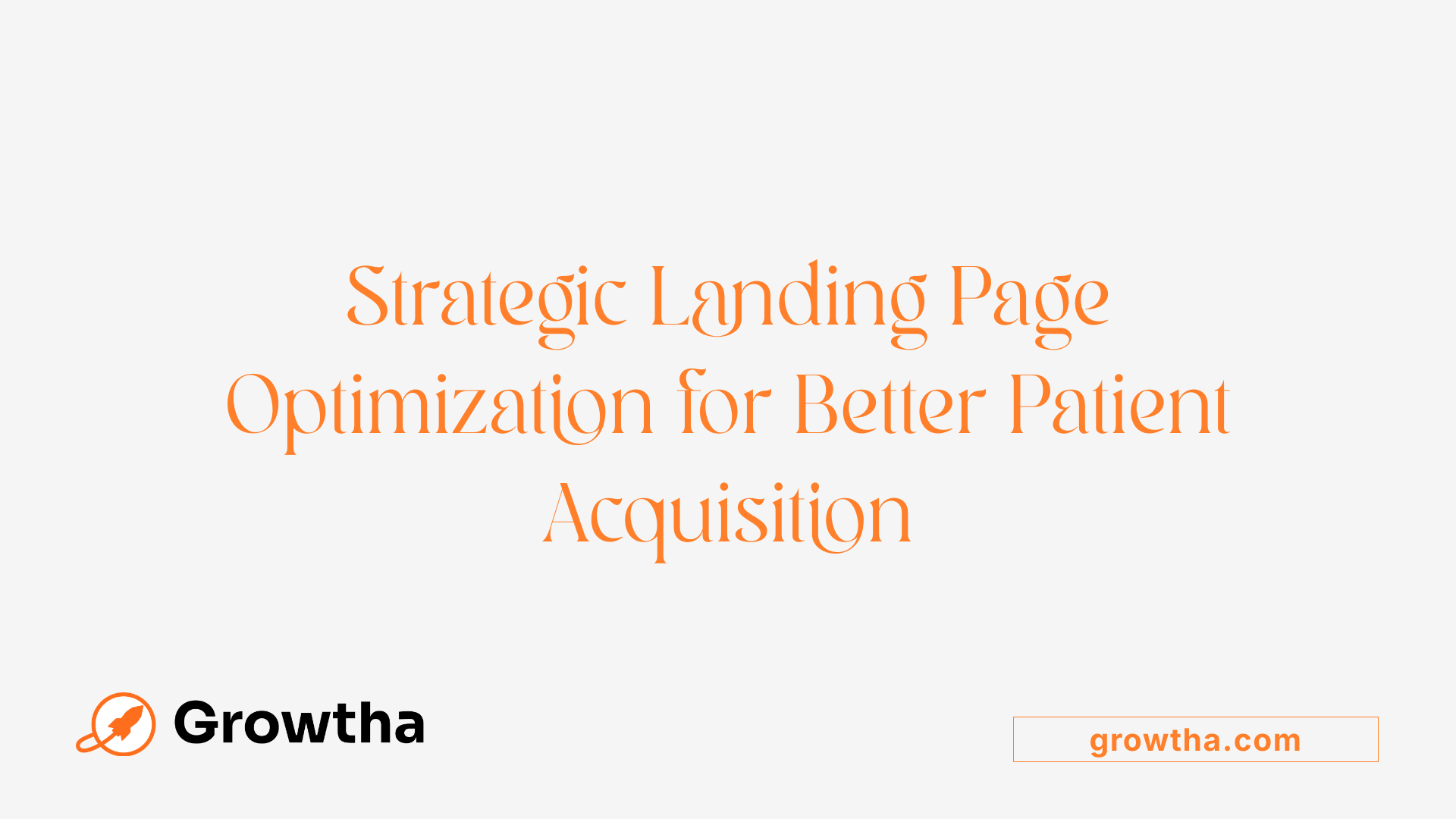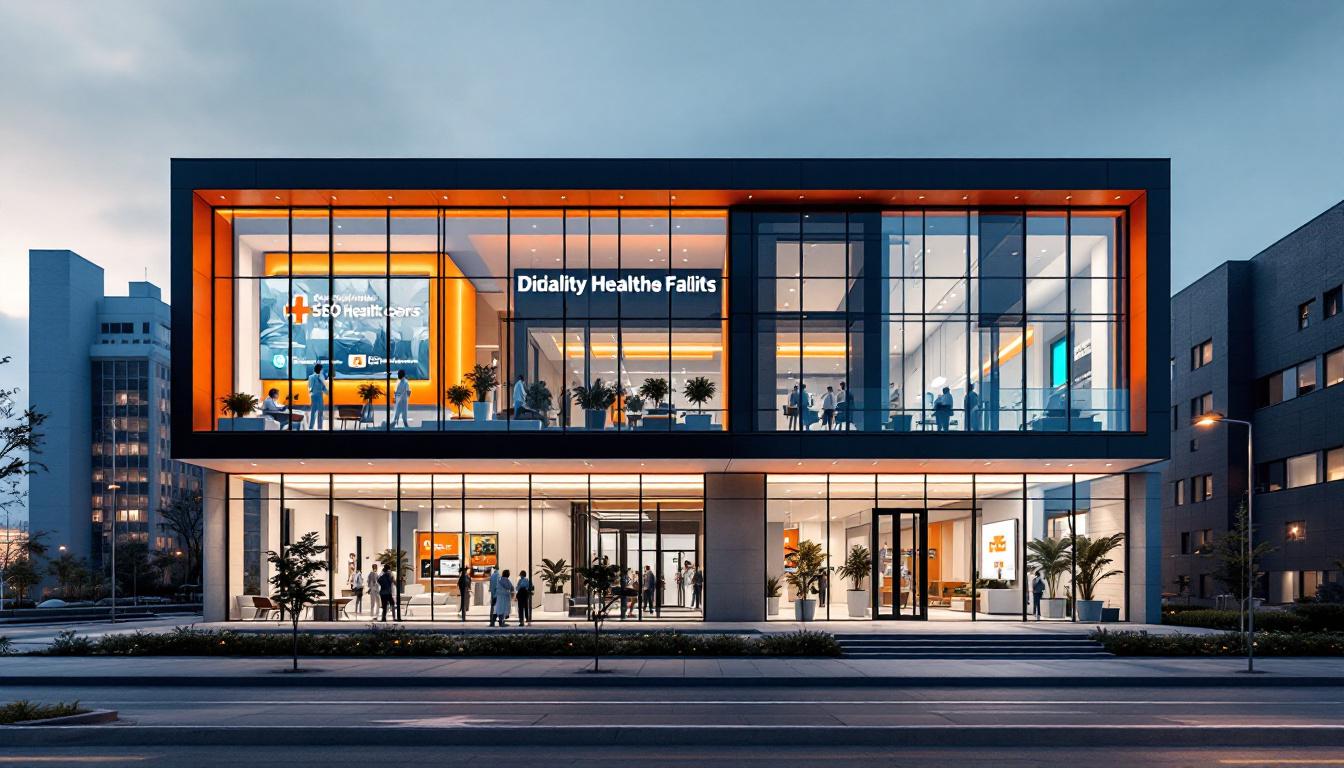How to Optimize Healthcare Landing Pages for Conversions
Boost Patient Engagement with Proven Healthcare Landing Page Strategies


How to Optimize Healthcare Landing Pages for Conversions
Unlocking the Secrets to High-Converting Healthcare Websites
Healthcare providers face unique challenges when it comes to converting website visitors into patients. With patients increasingly turning to online platforms for healthcare information and services, optimizing landing pages is essential to stand out and drive action. This comprehensive guide explores best practices, design techniques, content strategies, SEO tactics, measurement methods, and user engagement improvements to help healthcare organizations maximize conversions and enhance patient relationships.
Understanding the Critical Components of Healthcare Landing Pages

What content and layout elements contribute to higher performance of healthcare landing pages?
Effective healthcare landing pages excel by combining clear, reassuring messaging with a user-friendly design. They focus on core information that addresses patients' immediate concerns, avoiding complex jargon in favor of simple and accessible language. Prominent headlines and subheadings quickly communicate value propositions, while visual hierarchy guides visitors seamlessly through the content.
Trust signals like patient testimonials, certifications, and images of staff or facilities reinforce credibility. These elements bolster trust, making visitors more comfortable to proceed.
Strategically placed calls-to-action (CTAs), such as scheduling an appointment or requesting a consultation, provide clear next steps. Simplified forms with minimal fields—collecting only essential information like name, email, phone number, and appointment times—reduce friction.
A clean, responsive layout ensures the site works well across all devices, especially mobiles. Fast load speeds improve user experience, decreasing bounce rates.
Additional content like FAQs, educational material, and trust badges nurture credibility and help address visitor uncertainties.
Finally, ongoing optimization via A/B testing and analytics aligns content and design with user preferences, continuously enhancing performance.
How can SEO and traffic generation tactics be tailored to healthcare landing pages?
Optimizing healthcare landing pages for search engines requires targeted on-site strategies. Research relevant keywords that prospective patients use related to services offered. Incorporate these keywords naturally into page titles, meta descriptions, headers, and content.
Local SEO is especially important; optimize Google My Business profiles, create location-specific pages, and gather local reviews to improve visibility in local searches.
A fast, mobile-friendly, and accessible website improves user experience and search rankings. Utilize schema markup relevant to healthcare, such as medical services and reviews, to help search engines better understand content.
Off-site, build backlinks from reputable local organizations and healthcare directories, and maintain active social media profiles to expand reach. Consistent tracking of SEO metrics—such as organic traffic, bounce rate, and keyword rankings—guides ongoing adjustments.
What design techniques enhance the effectiveness of healthcare landing pages?
Effective design techniques include maintaining a minimalist aesthetic that reduces visual clutter and enhances focus. Clear visual hierarchy ensures key messages and CTAs stand out. Use high-quality, relatable images—such as staff or patient stories—to foster emotional connection.
Responsive design guarantees seamless experiences across desktops, tablets, and smartphones. Accessibility standards, like WCAG, ensure inclusivity for all users.
Incorporate trust signals such as security badges, professional credentials, and affiliation logos. Use contrasting color schemes for prominent CTAs to draw attention.
Video testimonials and explainer videos can increase engagement and convey credibility quickly. Consistent branding, clear typography, and straightforward navigation further improve usability.
How can healthcare landing pages be optimized to improve patient or lead acquisition?
Optimization focuses on simplifying the path from visitor to patient. Craft clear, benefit-driven headlines and subheaders that align with targeted ad copy.
Incorporate social proof like testimonials and success stories to reassure visitors. Use concise, compelling CTAs like “Book Now” or “Get a Free Consultation,” placed above the fold and at logical points throughout the content.
Make forms straightforward—asking only essential questions—to prevent abandonment. Use easy-to-find contact details, including phone, email, and physical address.
Ensure the design is fast-loading, mobile-optimized, and easy to navigate. Educational content, FAQs, and trust badges reduce uncertainty.
Regularly test different versions of page elements through A/B testing to identify and implement improvements, increasing conversion rates.
What methods can be used to measure and analyze the effectiveness of healthcare landing pages?
Use analytics tools to track metrics like conversion rate, bounce rate, time on page, and user interactions. Heat maps and click trackers reveal which elements attract attention and which are ignored.
A/B testing different headlines, images, CTAs, and layouts helps determine what performs best. Gathering user feedback through surveys offers qualitative insights.
Monitor key performance indicators regularly, and look for patterns that indicate success or areas needing improvement.
Utilize data-driven insights to refine content, design, and overall strategy, ensuring continuous improvement in lead and patient acquisition.
How can user experience and engagement be improved on healthcare landing pages?
Enhance usability by maintaining a clean, organized layout with clear navigation and intuitive flow. Use straightforward language and focus on a single primary messaging point.
Incorporate visuals like informative images, patient stories, and infographics that tell a compelling story and build trust.
Optimize loading speed and ensure mobile responsiveness to prevent user frustration.
Include trust builders such as reviews, certifications, and secure forms to increase confidence.
Implement accessibility features like ARIA labels and keyboard navigation to make pages usable for all visitors.
Regular A/B testing of content, design, and CTAs ensures the page continues to meet user needs and improves engagement metrics.
What actionable strategies can be used to optimize healthcare web marketing and increase conversions?
Combine local SEO efforts with high-quality, relevant content tailored to patient needs. Use targeted advertising campaigns on Google and social media to attract high-intent audiences.
Create dedicated, optimized landing pages for each campaign, aligning messaging with ad copy.
Improve website usability—fast speed, mobile-friendliness, and clear CTAs—facilitating easier user actions.
Showcase trust signals like patient reviews, testimonials, and professional accreditations.
Engage visitors through educational content—blogs, videos, FAQs—that establish authority and answer common questions.
Implement tracking and analytics to monitor performance, then refine strategies accordingly.
Building an active social media presence and fostering community engagement help nurture relationships and trust.
Monitoring key metrics like cost per lead, conversion rate, and return on ad spend allows for continuous optimization.
This detailed overview highlights how thoughtful content, strategic design, and ongoing analysis combine to create effective healthcare landing pages that attract and convert more patients effectively.
The Role of Trust and Credibility in Healthcare Conversion Rates

Why do trust signals, such as patient testimonials and certifications, matter so much in healthcare landing pages?
Trust signals are vital components of effective healthcare landing pages because they help establish confidence and reliability with potential patients. When visitors see authentic testimonials and reviews, they are reassured that other patients have received quality care and positive experiences. Testimonials often highlight specific benefits, fostering emotional connections and reducing hesitation.
Certifications and professional credentials further enhance credibility by demonstrating that healthcare providers meet high standards of quality and expertise. Recognized certifications from reputable organizations act as endorsements, alleviating concerns about legitimacy and safety.
Additionally, showcasing security measures such as HIPAA compliance notices and SSL certificates signals to visitors that their sensitive information is protected. This reassurance is crucial in gaining trust, especially in healthcare, where personal data privacy concerns are prominent.
Overall, these trust signals significantly influence decision-making, encouraging visitors to proceed with contact forms, appointment scheduling, or further engagement. They are especially important when the site visitor is unfamiliar with the practice or provider, helping turn cautious browsers into confirmed patients.
What content and layout elements contribute to higher performance of healthcare landing pages?
Effective healthcare landing pages boost performance through a combination of strategic content and thoughtful design. Clear, straightforward messaging that directly addresses the visitor's needs creates an accessible experience, steering away from complex jargon.
A compelling headline and subheader quickly communicate the value proposition, capturing attention immediately. Short, benefit-driven body copy emphasizes what the patient gains from the services.
Visual hierarchy plays a pivotal role—images of friendly staff, facilities, or relatable patients build rapport. These images should be realistic and emotionally engaging to evoke trust and empathy.
Trust signals such as testimonials, reviews, and credible badges should be prominently displayed. Including educational content like FAQs, videos, or infographics enhances understanding and positions the practice as knowledgeable.
Design elements like a clean, uncluttered layout, contrasting colors for CTAs, and fast load times contribute significantly to user experience. Responsive design ensures that the site functions seamlessly on smartphones and tablets, catering to the increasing number of mobile users.
Simplified contact methods, such as short forms asking only essential information, reduce barriers to engagement. Strategically placing calls-to-action (CTAs) at the top, middle, and bottom of pages guides visitors naturally through the conversion funnel.
Many successful pages employ ongoing A/B testing and analytics to identify and optimize high-performing elements continuously. Adjustments based on data insights ensure the layout and content remain aligned with visitor preferences.
How does ensuring compliance and security influence healthcare landing page performance?
Security and compliance are foundational to building trust on healthcare landing pages. Features like SSL certificates encrypt user data, giving visitors confidence that their information remains private.
HIPAA compliance notices, privacy policies, and transparent data handling explanations show a commitment to legal and ethical standards. These signals reassure visitors that their health data is managed securely, alleviating fears of breaches.
From a technical standpoint, secure and compliant sites often enjoy better search engine rankings, as search engines prioritize trustworthy websites. Non-compliance or lack of security measures can lead to reduced visibility and lower conversions.
Legal compliance also protects the healthcare provider from potential penalties, ensuring long-term operational stability. It contributes to an overall positive user experience, making visitors more willing to complete contact forms or schedule appointments.
In summary, demonstrating a strong commitment to security and compliance not only safeguards patient information but also enhances credibility, thereby improving conversion rates and fostering long-term trust.
The Impact of Mobile Optimization on Healthcare Landing Page Success

What design techniques enhance the effectiveness of healthcare landing pages?
Design techniques that enhance healthcare landing pages are essential to attract and convert visitors effectively. Creating a clean and straightforward layout with a clear visual hierarchy helps visitors navigate easily and find what they need quickly. Incorporating relatable, professional images and videos that resonate emotionally with patients builds trust and encourages engagement.
Prominent calls-to-action (CTAs), such as 'Schedule an Appointment' or 'Download Our Guide,' should be visually distinct and easy to click. Ensuring the landing page is fully responsive guarantees that it functions seamlessly across all device types, especially smartphones and tablets.
Accessibility should be a priority, following standards like the WCAG guidelines, making sure the site is usable for everyone, including those with disabilities. Adding trust indicators such as certifications, secure HIPAA-compliant forms, and doctor credentials further reinforce credibility.
Continual optimization using analytics tools, A/B testing different layouts, images, and messaging helps in refining elements based on user behavior. Ultimately, these design techniques collectively improve user experience, trust, and conversion rates.
Optimize your healthcare landing page for mobile devices to ensure maximum engagement
Optimizing for mobile is no longer optional; it is a necessity to maximize engagement. Start by adopting a responsive design that automatically adjusts to various screen sizes, providing a seamless experience whether on a smartphone or tablet.
Prioritize fast load speeds—compress images, minify code, and leverage browser caching to reduce bounce rates. Simplify navigation with touch-friendly menus and large, easily tap-able buttons to enable quick interactions. This ease of use encourages visitors to stay longer and engage more deeply.
Keep contact forms short, only requesting essential information like name, email, or phone number, which reduces friction and drop-off. Design CTA buttons with contrasting colors and prominent placement—above the fold whenever possible—to catch visitors’ attention immediately.
Use clear headlines and legible fonts to communicate your core message quickly. Regularly test your mobile site with device simulations and real-user testing to identify usability issues, then refine accordingly.
Implement accessibility features such as screen reader compatibility and high contrast modes to make your site inclusive. This broadens your potential audience and enhances user satisfaction.
By applying these practices, healthcare providers can significantly increase conversions, improve patient trust, and foster long-term engagement through mobile-optimized landing pages.
Integrating Landing Pages into Broader Digital Marketing Strategies

How can healthcare landing pages be optimized to improve patient or lead acquisition?
Optimizing healthcare landing pages involves several strategic elements aimed at capturing visitor interest and encouraging action. First, ensure that the messaging is crystal clear, with headlines and subheadings that directly address visitor concerns and highlight benefits. Using compelling, action-oriented calls to action (CTAs) like "Schedule an Appointment" or "Download Health Tips" clearly guides visitors on what to do next.
Trust signals such as patient testimonials, professional credentials, and certifications help establish credibility early on. Incorporating relevant, high-quality images that connect emotionally with visitors—such as photos of staff or satisfied patients—further enhances trust.
Design should be simple, mobile-responsive, and quick to load. Forms need to be streamlined—asking only essential information to reduce friction. Educational content like FAQs or health information can build authority and reduce uncertainties for hesitant visitors.
Continuous testing, including A/B testing of headlines, images, and CTA placement, allows ongoing improvements. Analytics tools monitor performance metrics such as bounce rate, conversion rate, and user engagement, providing insights for refinement.
In summary, aligning clear messaging, trust-building elements, minimalistic design, and consistent branding with advertising efforts forms the foundation of effective healthcare landing pages that convert visitors into patients or leads.
Why is consistency between advertising content and landing pages crucial in healthcare marketing?
Consistency across advertising and landing pages is fundamental in healthcare marketing because it minimizes visitor confusion and fosters trust. When visitors see a seamless message from an ad to the landing page, it reassures them that they are in the right place and that the services promised will be delivered.
This alignment includes matching headlines, visuals, value propositions, and the overall tone. For instance, if an ad emphasizes a specialized treatment for chronic back pain, the landing page should focus on that exact service without deviating from the original promise.
Consistency in branding also reinforces the healthcare provider’s credibility. It makes the user experience cohesive, which increases the likelihood of engagement—whether that means filling out a contact form, booking an appointment, or requesting a demo.
Conversely, discrepancies between advertisement promises and landing page content can lead to increased bounce rates and diminished trust, ultimately reducing conversions. Therefore, synchronized messaging across all digital channels enhances recognition, builds trust, and maximizes the effectiveness of healthcare marketing campaigns.
Connection with PPC and social media campaigns
Healthcare landing pages often serve as the endpoint for pay-per-click (PPC) advertising and social media campaigns. Creating dedicated, high-converting landing pages tailored to specific campaigns ensures that visitors are presented with relevant information aligned with ad promises.
For PPC campaigns, landing pages are optimized with concise headers, minimal forms, and clear CTAs focused on converting visitors quickly. They also include relevant keywords to improve Quality Score and ad relevance.
Social media campaigns benefit from engaging visuals, testimonials, and sharable content embedded on landing pages. Using targeted messaging and offering incentives such as health tips or downloadable resources can increase engagement.
Use of landing pages for multi-channel campaigns
In multi-channel marketing, consistent and optimized landing pages act as hubs for various efforts, including email marketing, PPC, social media, and content marketing. Their purpose is to guide visitors smoothly through the journey with a unified message.
Such pages should be adaptable, with elements like localized content or service-specific information to address different audience segments. Using tracking pixels and analytics data allows marketers to analyze which channels drive the most conversions and refine their approach.
Analytics and remarketing
Tracking user interactions through heatmaps, bounce rates, exit rates, and conversion metrics provides insight into landing page performance. This data guides ongoing improvements.
Remarketing strategies can target visitors who didn't convert initially by displaying personalized ads that lead them back to optimized landing pages, increasing the likelihood of conversion.
Regularly analyzing these metrics and conducting tests—such as adjusting headlines, images, or form fields—helps healthcare providers enhance their landing page effectiveness.
| Aspect | Strategy | Benefits |
|---|---|---|
| Optimization | Clear messaging, trust signals, minimal forms | Increased lead conversions |
| Consistency | Align ad and landing page content | Higher trust and lower bounce rates |
| Multi-channel | Tailored landing pages for each channel | Better engagement |
| Analytics | Heatmaps, A/B testing, remarketing | Data-driven improvements |
Implementing these integrated strategies ensures healthcare practices maximize the impact of their digital marketing spend, improve patient acquisition, and foster long-term engagement.
Achieving Long-Term Success with Optimized Healthcare Landing Pages
Optimizing healthcare landing pages for conversions is an ongoing process that combines strategic design, compelling content, technical excellence, and continuous analysis. Clear messaging, trust-building elements, mobile responsiveness, and seamless integration with broader marketing efforts lay the foundation for attracting and converting more patients. Regular testing, data-driven improvements, and adherence to compliance standards ensure that your landing pages not only perform well today but continue to evolve, adapt, and generate sustained growth. By prioritizing user experience and focusing on targeted, relevant content, healthcare providers can build trust, enhance patient engagement, and ultimately improve their practice’s long-term success.
References
- 13 Healthcare Landing Page Best Practices to Boost Conversion ...
- 6 Tips for a Medical Practice Landing Page that Converts
- 5 essential healthcare landing page tips | MPP - Media Place Partners
- How to Improve Healthcare SaaS Lead Conversion With a Strong ...
- Conversion Rate Optimization Techniques that Drive Growth
- 12 Steps to Healthcare Landing Pages that Convert
- Best Practices to Enhance a Medical Website Conversion Rate
- High-Converting Landing Page for Medical Practices
- High-Converting Landing Pages for Medical Practices - SILVR Agency







